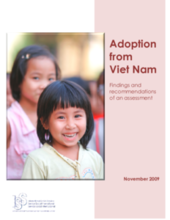The level and nature of intercountry adoptions (ICA) from Viet Nam are essentially influenced by foreign demand. Thus, the availability of children who are “adoptable” abroad corresponds more to the existence of foreign prospective adopters than to the actual needs of “abandoned” and orphaned children. As a result, the overwhelming majority of adopted children are under 1 year of age, the age-group most sought by prospective adopters. Since only a relatively small and ever-decreasing number of other “countries of origin” are currently making children of this age “adoptable” abroad, foreign actors have proved willing to accept conditions put in place by Viet Nam for processing these adoptions. There is also considerable pressure from abroad for Viet Nam to continue as a “source” of very young children.
The circumstances under which babies become “adoptable” are invariably unclear and disturbing. Declarations of so-called “abandonment”, which is notoriously difficult to investigate, are intriguingly frequent, but with unexplained “peaks” and “troughs”. Procedures for verifying the child’s status and, inter alia, for ensuring free and informed consent to adoption are inadequate and inconsistent.
Decision-making on the availability of a child for ICA as opposed to a domestic solution (including return to the biological family) seems to take no account of the subsidiary nature of adoption abroad, with little or no effort being made to establish the child’s real need for the latter or to identify in-country care opportunities.
The ICA procedure is influenced by a remarkably unhealthy relationship that can exist between agencies and specific residential facilities. It involves compulsory and sizeable financial contributions by agencies in the form of “humanitarian aid” to facilities that they themselves have identified as potential “partners” in ICA. The question of “aid” generally seems to be given far more importance than ensuring that ICA is resorted to as an exceptional measure on a case-by-case basis. Agencies compete with each other to secure children and tend to expect that children will be “indicated” to them for ICA processing according to the amount of humanitarian aid provided. Agencies are subject to little or no monitoring, and neither they nor the residential facilities they work with have any incentive to address or notify problems, since the way the system presently functions is to the advantage of both.
Governments and Central Authorities of “receiving countries” – collectively at least, and individually in many instances – have not effectively committed themselves to applying the basic principles of the THC-93, or the recommendations of the Special Commission on the treaty’s practical operation, in their dealings with Viet Nam. They have therefore been sending out mixed – and hence eminently unhelpful – messages on the acceptability of the current system. These frequently seem to respond more to pressures within their respective countries than to tackling identified problems. In most cases, embassies have virtually no knowledge of how their country’s agencies are operating, let alone being in a position to verify the compliance with international standards of adoptions to their country.
Viet Nam’s desire for rapid accession to the THC-93 constitutes a highly positive perspective. It will nonetheless require not only far-reaching legislative changes, which Viet Nam already envisages, but also a fundamental change in outlook, including in particular a total divorce between “humanitarian aid” or other financial contributions and the ICA of those of its children who may require this measure.
The success of reform efforts will depend not only on Viet Nam itself but also on the willingness and ability of foreign actors other than agencies to provide active assistance, including in the development of preventive child welfare measures and of functioning child protection systems, based on a deinstitutionalisation strategy and the consequent expansion of alternative care options for vulnerable children.

